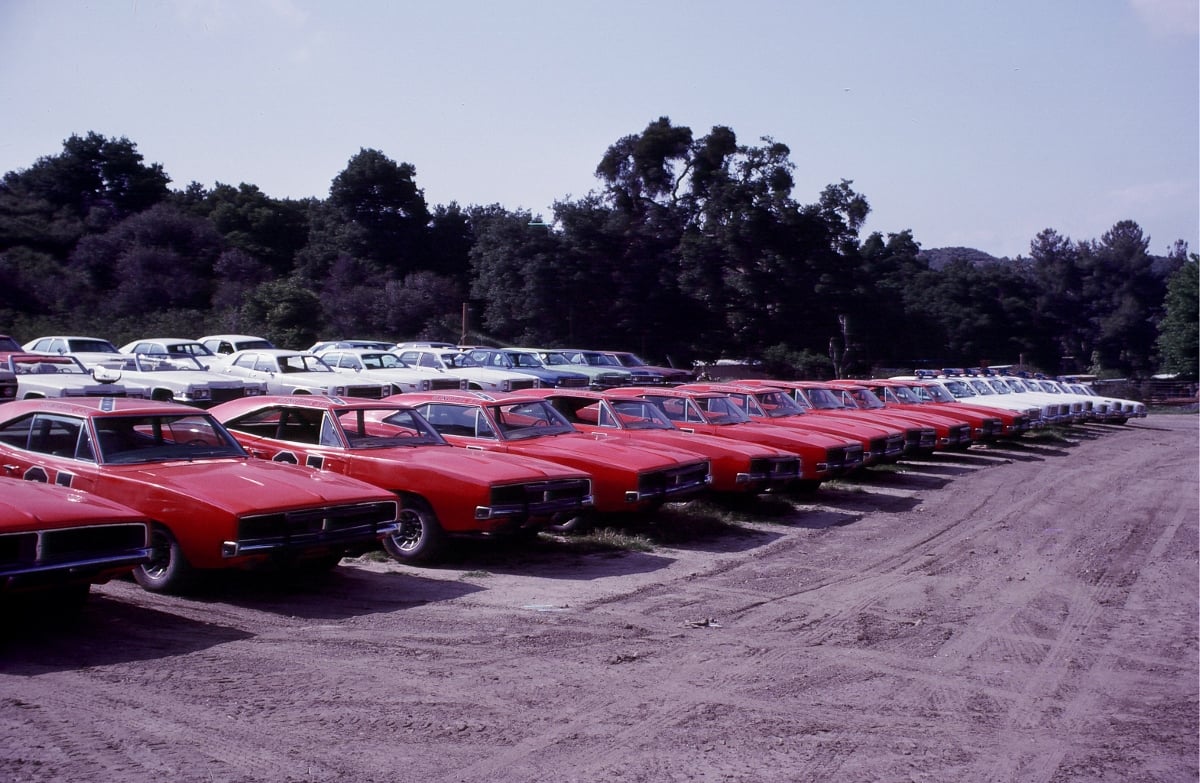Behind the scenes stories from the men who built the most famous Charger in history
Words: Cam Benty and Tom Sarmento; Photos: Tom Sarmento
If you took a flight out of Southern California’s Burbank Glendale Airport (now called Bob Hope Airport) in 1983, you might have spotted an unusual sight just before you reached the end of the taxiway and turned tail to line up with the runway — a Rebel flag flying high from a lone flagpole just across the street.
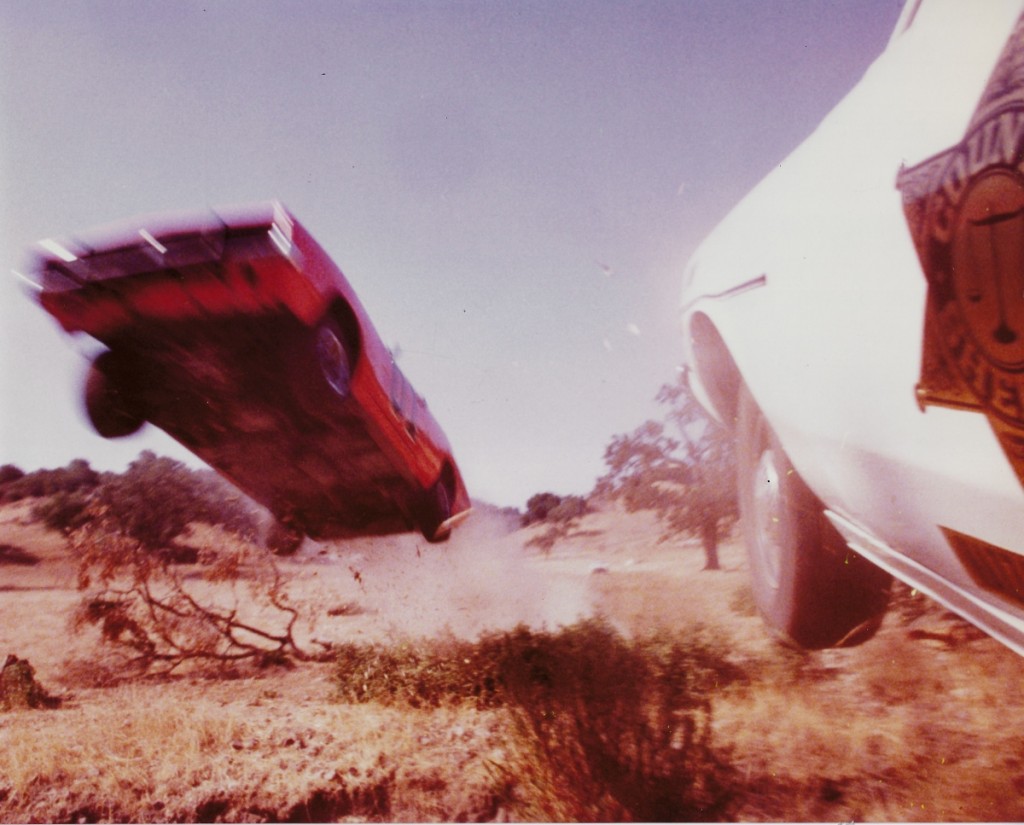
Running from 1979-1985, The Dukes of Hazzard was famous for filming action scenes like this. No other car in history was filmed from the underside more than the General Lee Charger.
At the base of that flag, a war of time and attrition was waged daily – not as occurred back in the time of the War Between the States – but rather a man vs. machine conflict of legendary proportions. A small group of mechanics and special effects guys worked to keep the fleet of General Lees outfit with proper engines, roll cages, and suspension parts. While the General’s battles were carefully captured on film to the delight of an avid television audience, only this band of talented warriors knew the behind the scenes tasks necessary to keep them “flying” every time Second Unit Director Paul Baxley yelled “ACTION.”
The Dukes of Hazzard television show ran from 1979 through 1985 and was always top-rated on CBS during that time. With actors John Schneider and Tom Wopat behind the controls of their legendary 1969 Dodge Charger, complete with NASCAR-style race cars and 01 emblazoned on the side, the car is arguably the most famous TV vehicle of all time. Yes, bigger than the Batmobile, Knightrider, and even Burt Reynolds’ Bandit TA.
Responsible for all of the 317 Chargers used on the show during its six-year run was Builder/Lead Mechanic Tom Sarmento, who to this day stages DukesFest in the southeastern U.S. and attends other events both here and internationally. Some 30-plus years after that last orange Charger flew across the screen, the General Lee and the folks who made it popular – regardless of their roles – are celebrities with a diehard fan base.
The Dukes infantrymen
While Sarmento was responsible for the timely operation of the cars on the set when called to perform, he also created an amazing team of “technicians” who worked tirelessly to build cars for both First and Second Unit filming. As with most productions, First Unit cars worked with the actors themselves, often on location or on stage. Second Unit cars did all of the stunts, big and small. Dukes’ Second Unit tasks could range from driving action around the location, “mini-jumps” where the car hops off a short jump before returning to the ground, to full-scale ramp-to-ramp (and ramp-to-nothing) “flights”.
John Cade and Corey Eubanks did 40 percent of the jumps on Dukes, backed up by Al Wyatt and Henry Kengi. While it was Wyatt who holds the record for the longest jump (236 feet), in terms of sheer volume, Cade and Eubanks have the most total airtime.
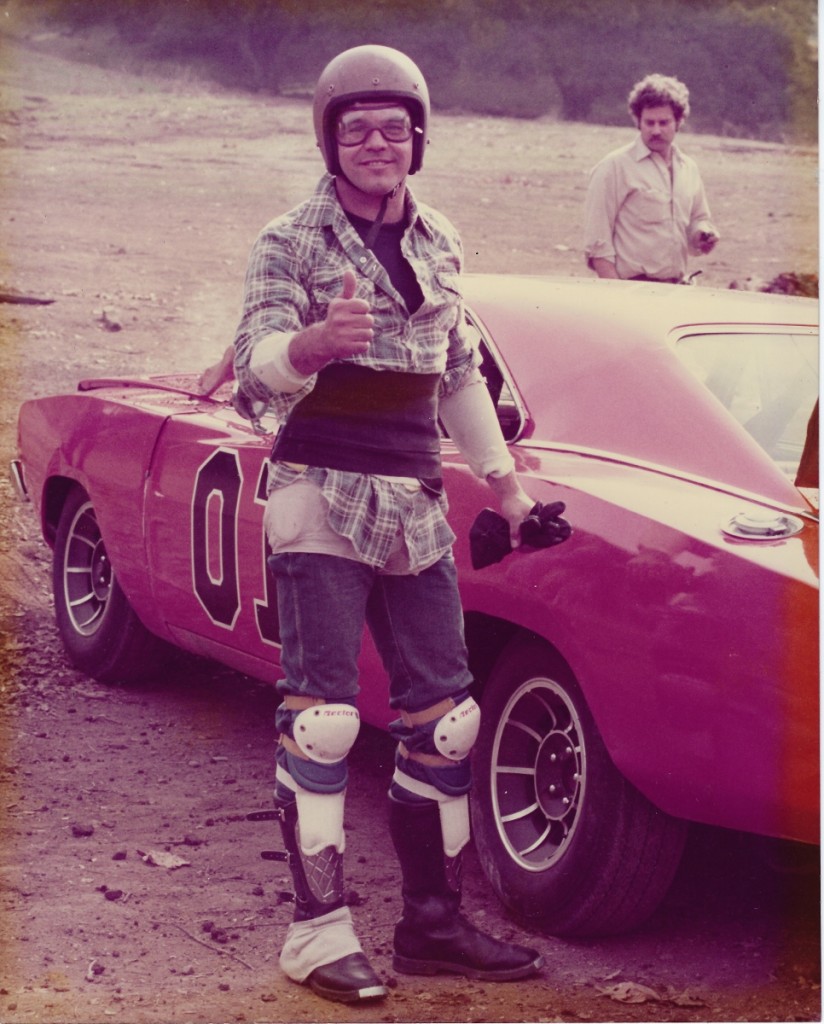
Stuntman John Cade suits up for duty. Looking more ready for a football game than a car stunt, this protective gear was typical of the “safety” equipment used for the show.
“For each show, we figured we needed at least six General Lee Chargers, eight Sheriff cars, two Jesse pickups, two Daisy Jeeps, two Boss Hogg Cadillacs, and at least six non-descript cars at the ready between First and Second Unit,” Sarmento says. “We had to have plenty of back-ups because we knew that things happen; guys run into trees, cars flip over, etc., and we had to have extra vehicles if there was a jump. Things really got interesting when we moved from Lake Sherwood, which is where most of the show was filmed, to subsequent locations such as Indian Dunes, Disney Ranch, Columbia Ranch, Castaic Lake, and others before the final season at Valencia Oaks.”
The record for jumps in one day happened in February 1983 when nine Chargers were launched into the air. The reason for the huge number of jumps (most of the time, there was no more than one or two jumps in a week) was Executive Producer Paul Picard, who threatened to use stock footage, rather than film new action, thinking he could save money. Second Unit Director Paul Baxley wouldn’t have it, and to get the footage in the “can,”’ staged a jump fest all in one day.
None of the nine Chargers survived.
Vehicle prep
“On my first day at Dukes, I arrived on location in Valencia, California, around 5 a.m. in my converted bread truck full of tools and supplies,” Sarmento remembers. “Transportation Captain Jack Oates was already out there. Upon seeing me, he simply pointed to the pile of Chargers over by some trees stating, ‘well, there they are.’ In all, there were about 15 Chargers lying in a heap with flat tires and dead batteries. So began my glorious career on Dukes.”
It didn’t take Sarmento long to get the cars up and running. Tires and batteries were easy, and after a few other simple corrections, Sarmento felt they were back in business, so he took a break and filled up his coffee cup. Once again, it was Oates who was to spoil Sarmento’s morning, pointing a finger at the stack of Chargers and commenting, “looks like your Chargers are on fire!”
Sure enough, the cars were doing one of two things: either generating huge plumes of steam as they overheated, because of busted radiators and hoses, or leaking oil all over the ground. Clearly, the General Lees had been worked hard and required a lot of attention just to get them to run, let alone perform. Sarmento’s saga had just begun.
If there is a silver lining to the story, it was that as a result of the poor condition of the picture cars, Sarmento and his good friend, Rich Sephton, made a living turning junk cars into reliable picture vehicles using skills honed building their personal race cars.
It did not take Sarmento a lot of convincing to make Executive Producer Paul Picard understand the need to have cars that do what the director wanted when he yelled action. Spending a little more money to avoid downtime made a lot of sense.
“While the police cars were fairly new (1977-78), the Chargers were falling apart,” Sarmento says. “We picked them up from all over Los Angeles, and we rarely paid more than $500. The transportation people in charge of the cars didn’t know the difference between a 318 and a 440 [c.i. engine]. Back then, you could get even Charger R/Ts for under $1,000. It seemed like most of them were green for some reason — clearly that was a popular color from the factory. More than once, we spotted a car on the street, knocked on the door, offered $500 for the car and a clean title. Those were the days of cheap and plentiful muscle cars.”
Giving the General a hand
Warner Brothers producers had no clue what it would take to get the Chargers to not only fly through the air, but simply operational. Most of the Chargers were equipped with big-block Mopar engines ranging from 383 to 440c.i. Small block-powered cars were used for mid-sized jumps, with nitrous oxide giving the cars the added lift. When a car was required to slide around in the dirt during a chase or complete other dynamic driving, a 383c.i. or bigger cube-equipped car was preferred, because they had the necessary torque.
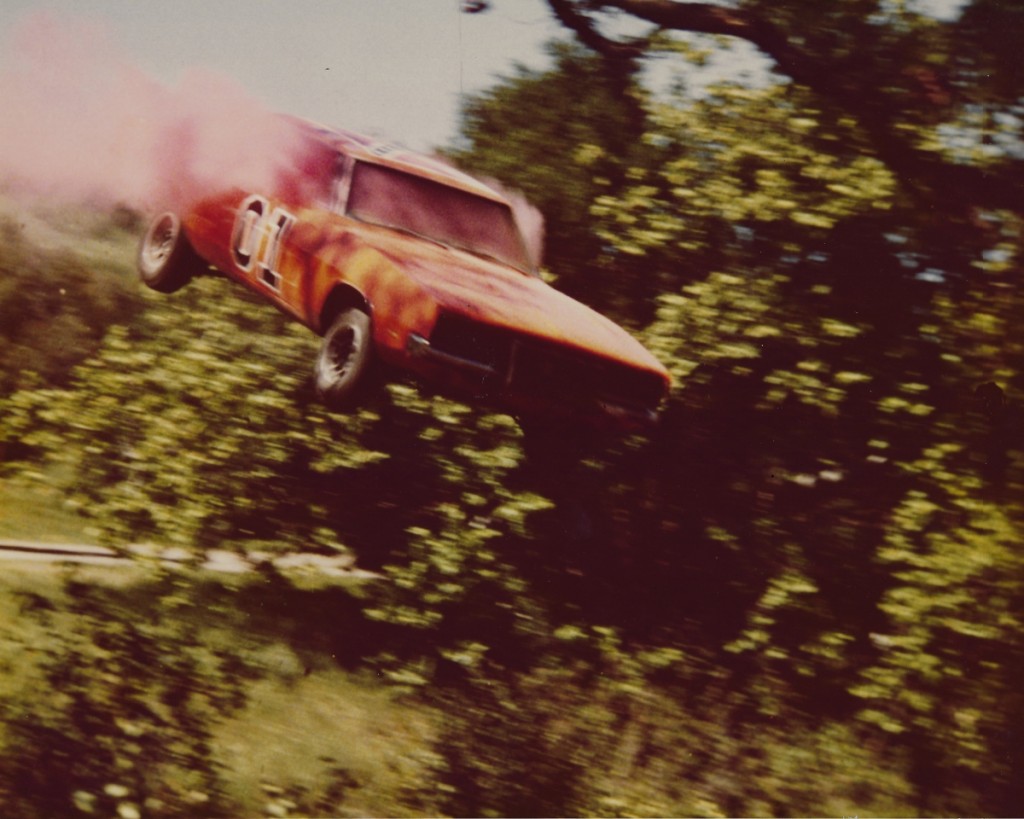
As stuntman John Cade tells it, the red smoke was supposed to clear out once the car became airborne, a smoke bomb firing off after the car hit the ramp. Clearly, the special effect guys were wrong.
As with most accounting departments, they began to become very concerned about overruns of the budget down at Warner Brothers headquarters. To that end, the guy charged with riding hard on the guys at the mechanics shop was affectionately nicknamed “Clip Board Steve,” because of his obvious and ever-present clipboard. Every day, he would arrive at the show to tally the parts required to keep the Chargers coming down the line — and take some torment from the mechanics.
Short story – If you remember that flag pole mentioned in the beginning of the text, the tubing used to create the pole was actually delivered to the shop to create a stronger thicker-wall roll cage for one of the bigger jumps planned for the show. When Clip Board Steve arrived, he was unable to find the tubing. After some searching, the mechanics caved and showed him the flagpole they had made out of the tubing. Their rationale: They had stacked it vertically.
Sometime in 1982, Clip Board Steve decided Sarmento should begin keeping a log of the cars and repairs, not just the Chargers, but all of the police cars and other vehicles. What remains are the logbooks that now place the times and dates for each jump and verifies the total cars used. That’s priceless information for car guys.
The big jumps
“Someone had installed a 413c.i. big block in one of the Chargers — the early style Mopar engine — as odd as that would seem,” Sarmento says. “To make things more unusual, the car also had a 4-speed transmission. It is the only manual transmission car I can remember from my days on the show, because the stunt guys didn’t like them because there were too many pedals to contend with. Between the gas and brake and the parking brake (the latter used for fast sliding turns — the ratcheting mechanism was removed so the brake could be depressed locking the rear tires — and then released once the driver had made the turn), there was just too much to handle.”
Wyatt completed the biggest jump ever for Dukes, at 236 feet, but Cade’s 186-foot jump in Oxnard, California, over a moving train was one of the most dramatic. The prep completed to launch the Charger at the right angle was typical of how it was done.
“When they strapped me in the car, I found that I could not reach the gear shift,” Cade says. “The gear I needed was third, which was the furthest away from me, so they taped the gear shifter into third which meant that I had to feather the clutch to get the car to move and get up to speed without shifting.”
“Strapping in” a guy in a stunt car was fairly unusual at the time, but something that would seem extremely unsafe by today’s standards. The driving suit used at the time was not really the typical flame retardant race car suit you might imagine. Frankly, it was more like the gear you might find on a football player. Ankle, elbow, and knee guards were required, along with protection for the kidney, hips, and forearms — topped off with an open face helmet. But, that wasn’t always the case.
“Al Wyatt was wild man,” Cade remembers. “For his record jump, he wore shorts and flip-flop sandals.”
The strapping in operation took several minutes and, interestingly enough, utilized a lot of original Chrysler parts, including the factory Charger seat.
“We would start by welding eyelets into the roof of the car after the headliner had been removed,” says AJ Thrasher, the Dukes’ roll cage specialist. “Once the eyelets were in place, the harness for the driver was hung from these eyelets, so that the stuntman suspended within the car.”
To provide protection against compressing the stuntman’s spine into the seat and flooring, the Chrysler seats where slit open and a truck tire inner tube was stuffed into the seat. The harness provided five-point retention, but the driver was actually floating in space once the inner tube was aired up. No window netting to retain driver arms and heads was used (that would show in the filming, remember), and often a wig was attached to the outside of the stuntman’s helmet to make the camera believe John Schneider was behind the wheel. On more than one occasion, Cade ditched the inner tube and inserted a large wadding of bubble wrap under his spine as his only seat cushion.
“We felt safe in the cars using this system and knowing that the roll cage system built by [AJ Thrasher] was done right.” Cade says. “AJ was constantly chewing Redman [chewing tobacco] when he was working. He signed off the car with a big wad of used chew that he would leave on the dashboard. If we saw that AJ had left his ‘mark,’ we knew the car was good to go.”
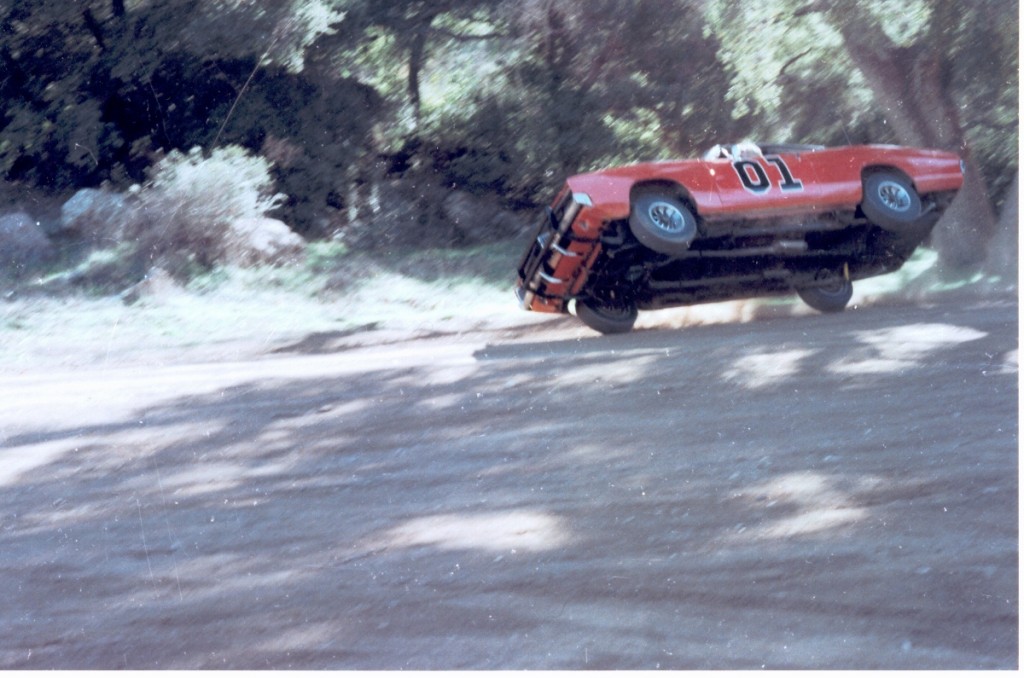
Legendary “ski” car driver, Buzz Bundy did all of the two-wheel stunt driving at that time — for most of the TV and film industry. No one was faster or better at driving on two wheels, and the Duke’s Charger was one of his favorite rides.
The choreography of the jumps was tuned to the production requirements. The angle of the ramp and the speed of the car were obviously determiners of how high and far the car would fly. After the director had determined the shot he wanted, it was up to the stunt man and vehicle prep team to calculate the details of the flight.
In the beginning, there was a lot of trial and error. Often, the Chargers would nose in, and the car would clearly have been totaled. As the jump team became more attuned to Charger aerodynamics, they would begin installing lead weights into a trunk-mounted box to even out the weight balance. For the small-block Charger, 300 extra pounds were installed in the rear, for the big block, 500 pounds.
Initially, the producers did not expect The Dukes of Hazzard “to go past the first commercial” in terms of longevity. But 40 years later, Dukes is still a thing, and Sarmento has had an illustrious career in the TV business, highlighted by his time turning wrenches on Chargers and making them fly — quite literally.
In the end, Sarmento sums up the overall experience and gives credit to his fellow mechanics and the cars that served him so well.
“My cars worked hard, performed great, and died a rough death,” Sarmento says. “My time on the show was unforgettable, and I’d do it again if given the chance. It was a terrific time in my life.
Dukes Myths
Insider Trading on the General Lee from Tom Sarmento
- The doors were never welded. How else would Uncle Jessie or Boss Hogg ever get into the back seat of the cars?
- Only 1969 and modified 1968 Chargers were used. No 1970s, for obvious reasons — there are lots of incorrect rumors to the contrary.
- The roll cage in the car is wrong for safety’s sake, the rear diagonal protecting the passenger side so that John Schneider could be seen in filming from the back seat of the car: Hollywood stuff.
- 317 Chargers were used — all taken from Los Angeles County.
- Big-block Mopar engines powered most of the cars. When used for First Unit filming, where the cars had to slide around a kick up the dirt, the 383c.i. engines were preferred.
- To achieve the right angle when flying, and avoid the “nose in” damage they experienced in the first test flights, 300 pounds of lead was installed in a weight box in the trunk of small-block cars, 500 pounds in big-block cars.
- Most of the cars received some form of roll-bar hoop installed by AJ Thrasher. For the bigger jumps, a full cage was installed to protect the driver. The cages, big and small, used high-quality tubing.
- Guy Waldron, creator of the original General Lee (as opposed to rumors about George Barris), wanted a Pontiac GTO. There were 180,000 Chargers built back in 1969, so by virtue of availability, that model was the final choice.
- The original horn used on the General Lee was heard first on a food truck by Director Paul Baxley and then used on the show. Only one car was equipped with a real horn — the First Unit car driven on stage by Schneider and Wopat.
Original Stuntmen: Paul Baxley, Craig Baxley, Gary Baxley, Henry Kengi, Bobby Orrison, Al Wyatt Jr., Jerry Summers, Kay Kilmer, Richie Burch, Corey Eubanks John Cade, Russell Solberg,
Mechanics: Tom Sarmento, Rich Sephton, John Mancini, Mark Lilienthal, David Grant


